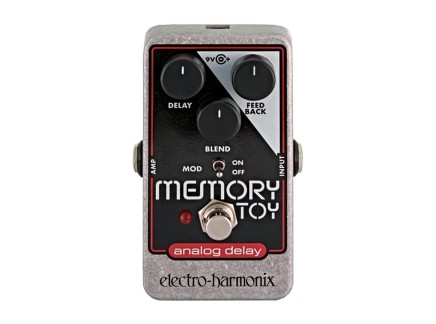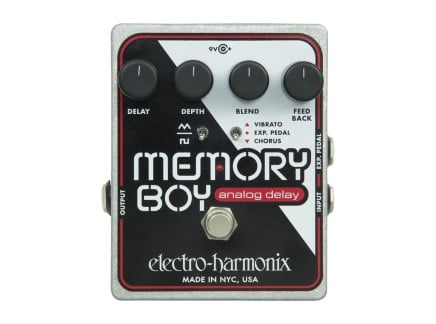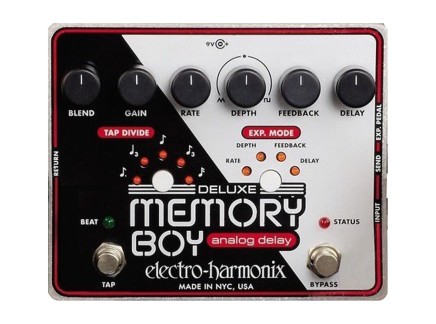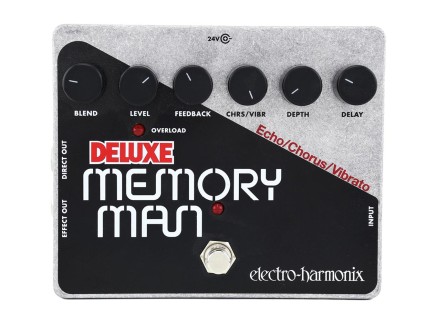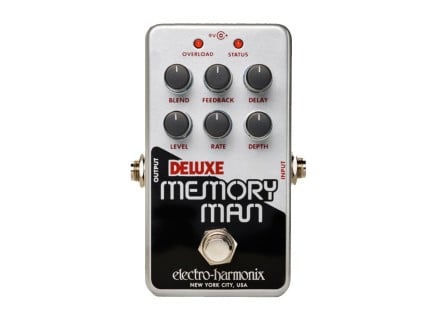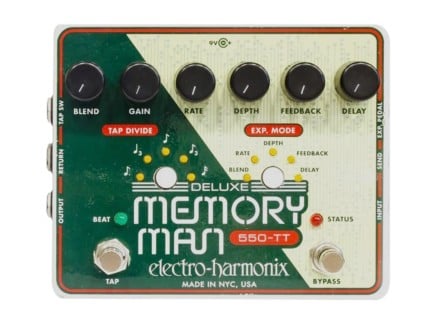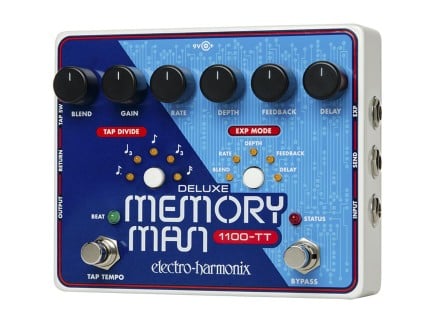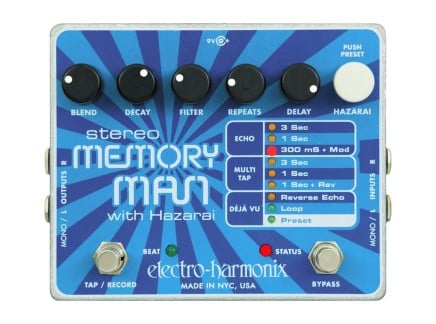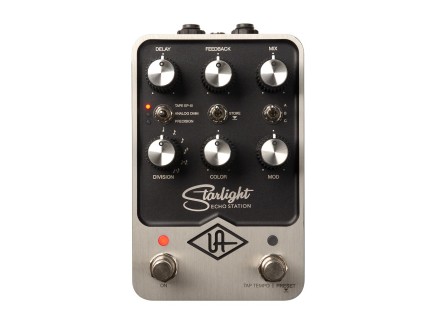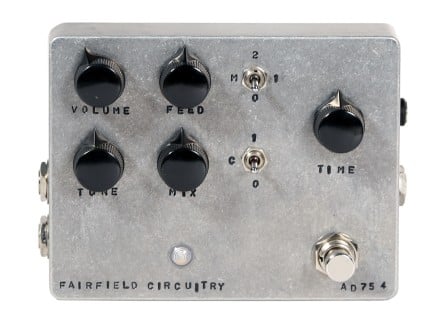Through the course of guitar effects history, few delay pedals have had the staying power of the Electro-Harmonix Memory Man series. With a reach that extends well beyond guitarists and bassists, musicians and producers of all genres have turned to the Memory series for delivering its tried-and-true flavor of analog delay, chorus, and vibrato effects.
Today, there's a number of entries in this family of delays, but what makes each of them unique? In this article, we'll cover the full range of Memory pedals, from the simplest offering to the most feature-packed option available, and shine some light on the rich history of these legendary effects.
A Brief History of Analog Delay
Humans have likely been fascinated with audio delays since the dawn of time, upon discovering the joy of hearing echoes after shouting into expansive natural formations, like caves and canyons. Musically speaking, composers have long experimented with repeating musical phrases in the form of rounds, canons, and other styles of transcending time via multiple musicians or contrapuntal lines. But the first useful instance of musicians being able to directly interact with a time-offset version of their own playing didn't come until the early 20th century, during the development of audio recording technology.
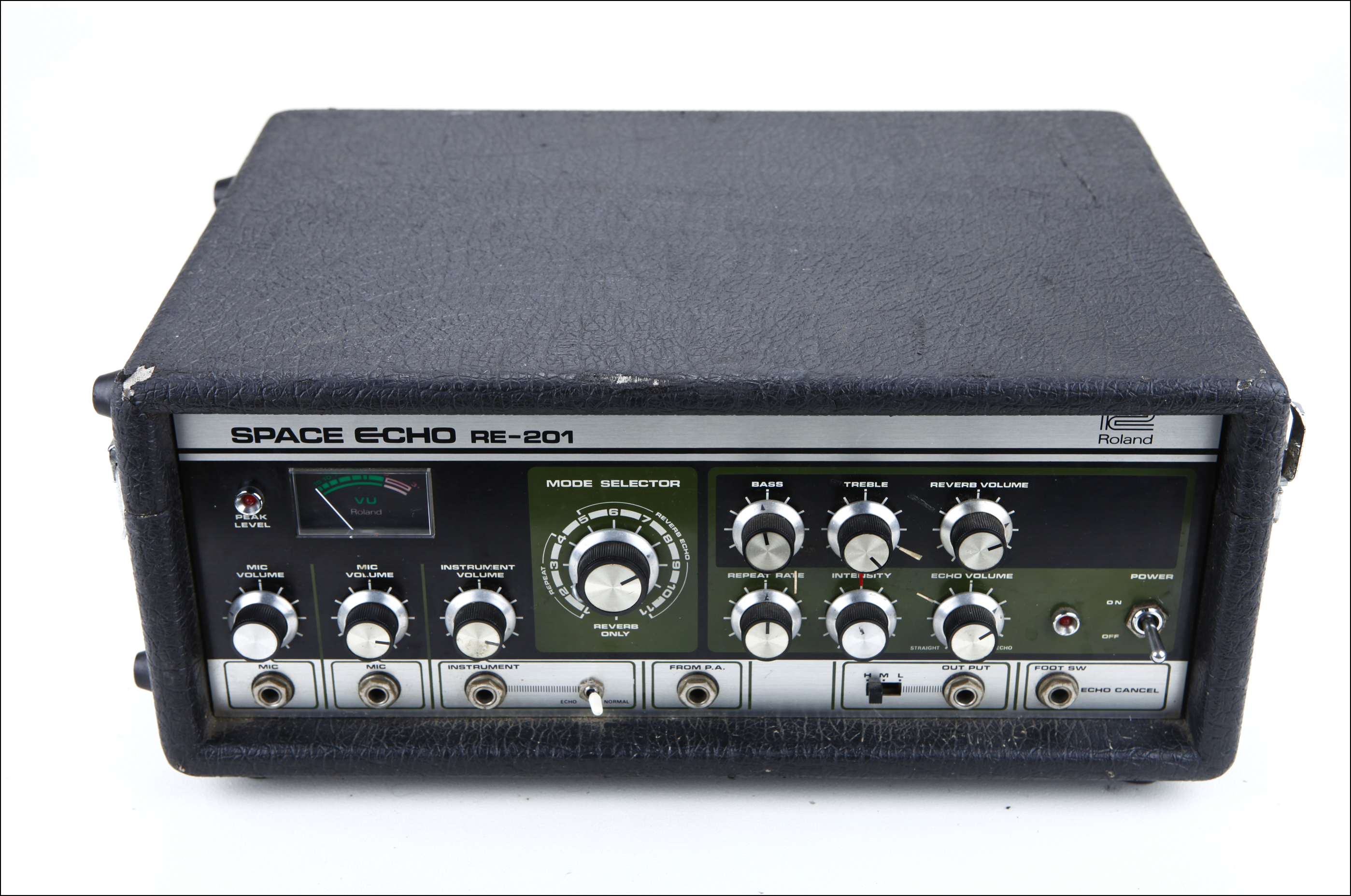 Roland's RE-201 Space Echo
Roland's RE-201 Space Echo
Through advancements in technology, as well as trial and error, echo and delay effects soon became rather desirable in the studio, and eventually gave way to the development of dedicated effects processors. As tape was the predominant recording medium at the time, tape delay units like the Maestro Echoplex and Roland RE-201 Space Echo came into prominence in the 1970s. Other methods of creating delays did exist, such as the cylindrical drum-based Binson Echorec and the curious oil can Tel-Ray Ad-n-echo, but tape delays certainly reigned supreme.
The principle concept of a tape delay is simple: some amount of tape, usually fashioned into a loop, travels near a magnetized record head, which transmits incoming audio onto the tape. The tape then continues to move along until it reaches one or more playback heads, and will continue to loop around until it reaches an erase head that clears the tape, before looping around and recording onto it again. In the case of the Echoplex, delay time is manipulated by physically moving the distance between the record and play heads, whereas the Space Echo simply modifies the speed at which the tape is moving. But of course, anything based around a mechanical design requires regular maintenance to keep it up and running, so while their sonic characteristics are certainly desirable, they're not always the most reliable pieces of equipment, especially for those bold enough to bring them along on tour.
Due to their size, complexity of construction, and general reliability concerns, effect makers were looking for alternatives to bulky tape systems. But by the mid-70s, a new type of technology known as bucket-brigade devices, or BBDs for short, became the answer. A BBD involves a large number of capacitors and switching transistors clocked at a high rate, where briefly stored voltages are passed from one stage to the next—much like a brigade of old-school firefighters passing buckets of water down the line. Because capacitors are able to briefly store electrical charges, chaining a high number of them together with a series of sequentially opening and closing switches makes it possible to capture voltages and reproduce them at a later point in time. With enough stages and a high enough clock rate, this can be effective for creating audio delays.
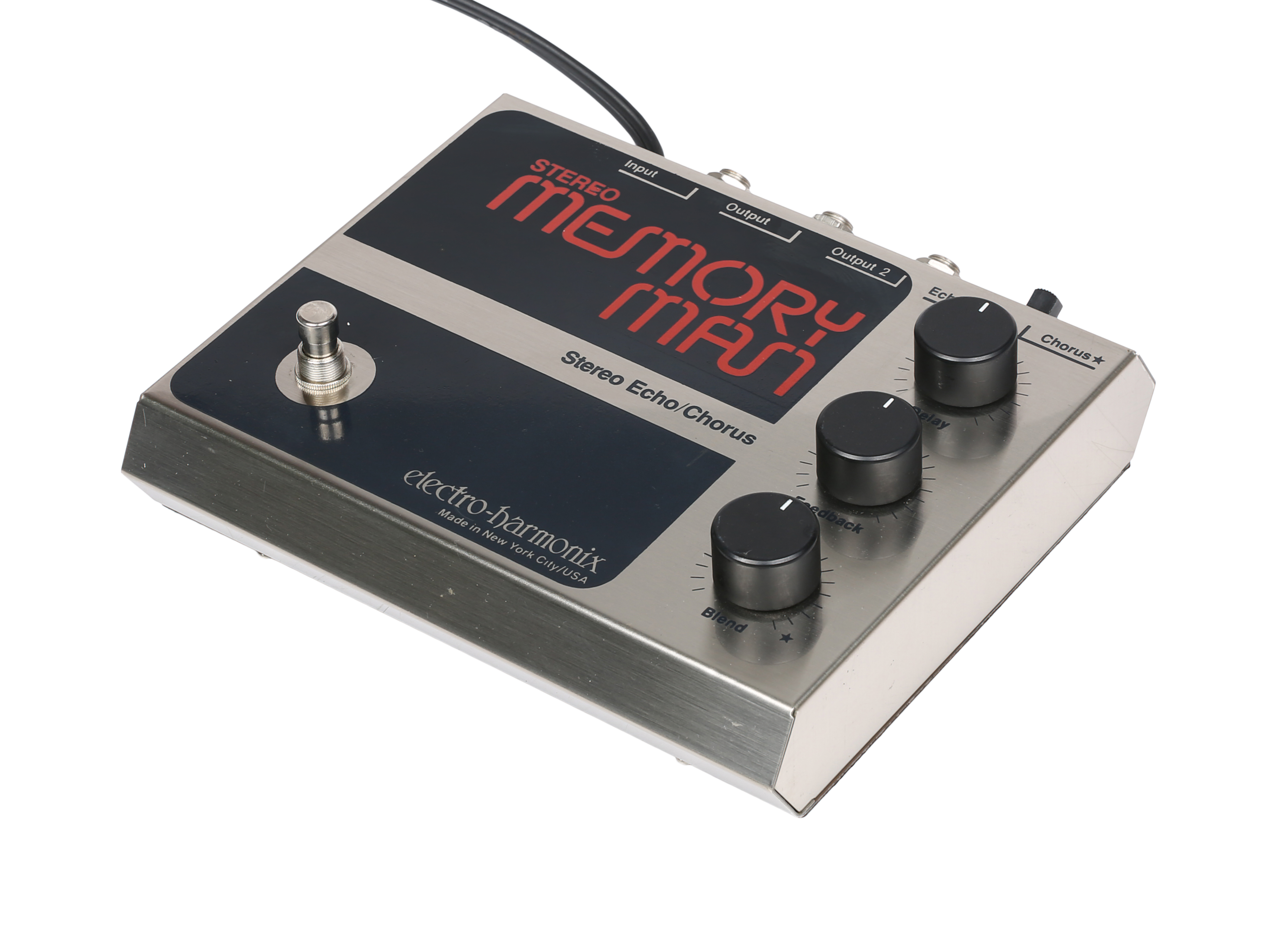
In the context of a delay effect, a BBD isn't too dissimilar to a digital audio buffer, in that they both store snapshots of an audio waveform at discrete points in time, and may be indexed through at slower speeds for longer delay times with a decrease of audio quality. But much like how a digital buffer requires more memory to store longer snippets of audio, BBDs require more physical stages for generating delays at a respectable fidelity. Like digital storage, it's common to see BBD chips with a number of stages as a large power of two, such as 512, 1024, and 2048. There were a number of chips on the market at the time, but perhaps the most popular choices included Reticon's SAD1024 and Panasonic's MN3005. To this day, functioning pedals and effects processors with these components continue to be highly sought after and fetch a hefty price on the used market.
Of course, with the advent of microprocessors and digital computing, digital effects rose to the forefront of recording and performance tools a few years after BBD delays hit the market. But with all that they have to offer in timing precision and pristine audio quality, there's something about the character of analog delay units that still appeals to many people. Much as how our ears have grown accustomed to the pleasing tones of vacuum tubes and other forms of analog saturation, the murky, warm sound of BBDs blends with so many instruments incredibly well. To this day a number of fantastic analog delays exist alongside digital effects, with plenty of options available in the world of delay pedals for anyone to get what they want.
Legacy of the Memory Man
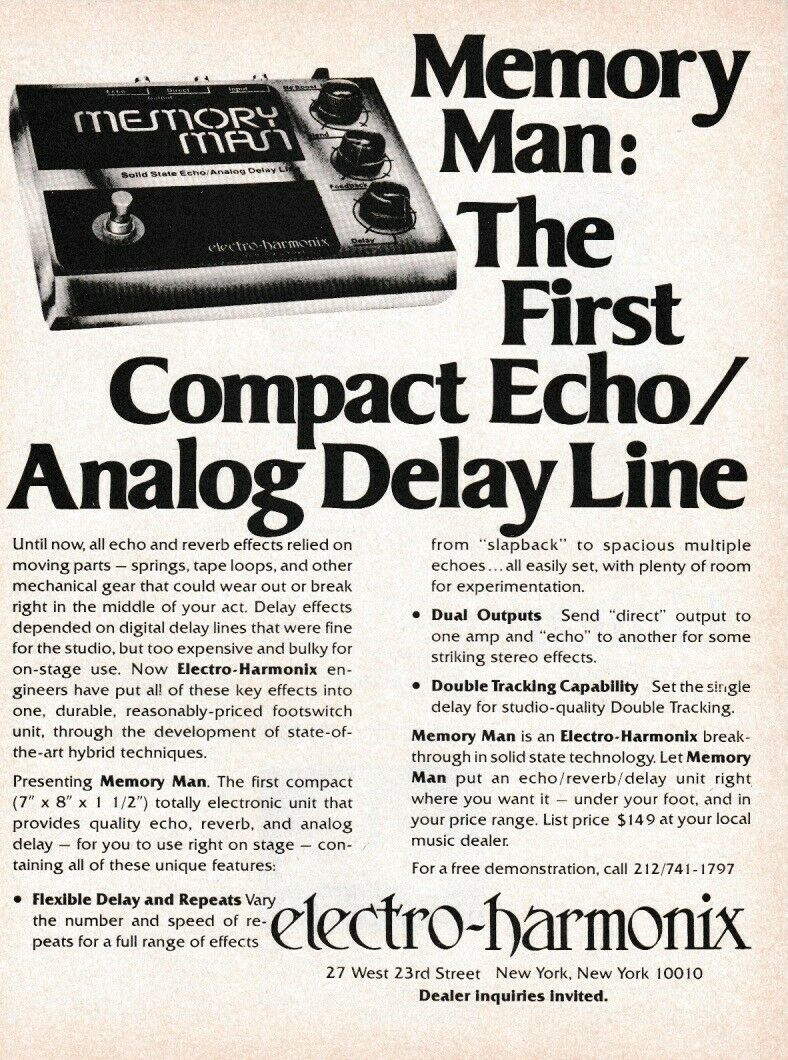
Given the rising popularity of BBD chips throughout the 70s, it was only a matter of time before pedal makers began working with them to give guitarists a more compact alternative to bulky and unreliable tape units. Of course, among the first to hit the market was, in fact, the original Memory Man. At this point, Electro-Harmonix was already notable for their Big Muff pedal which was used by the likes of Jimi Hendrix and David Gilmour, but the release of the Memory Man ushered in a new era of guitar pedal design. No longer simply used for tone shaping, like overdrive and wah effects, but now with delay, chorus, and flanger effects, guitars and other instruments were occupying sonic spaces that were previously impossible without access to a premier recording studio.
Guitarists were immediately enchanted by the characterful sound of the Memory Man, with a form factor that was a welcome change from large tape delays. But the version with the most lasting impact on the world of effects was the Deluxe Memory Man, which added an internal LFO to slowly shift the delay time up and down, thus slightly fluctuating the pitch. This extended the Memory Man from strictly delay effects into the territory of modulated delays that were somewhat like the wow and flutter heard in mechanical delays. But with both the delay time and feedback control at their minimum, it was also a superb source of chorus and vibrato effects, making it much more than a one-trick pony.
When discussing the Deluxe Memory Man, no historical conversation would be complete without mentioning U2 and their guitarist The Edge. Listen back to almost any of their hits and you're nearly guaranteed to hear the sound of the beloved EHX delay, whether it be "Sunday Bloody Sunday" or "Where the Streets Have No Name." But this pedal has found a home with an incredible number of artists, from Radiohead and J Mascis to electronic musicians like Venetian Snares and Oneohtrix Point Never.
Modern Memory Man Options
Thanks to the enduring legacy of the original, the Memory Man family is alive and well today, with several models currently available to carry the torch of lush analog delays. Now, we're going to take a look at the entire line, which, at the time of writing, contains an impressive total of eight different pedals. While they share some common traits, there's still some differences between each of them, offering a particular set of features to target the specific needs of players and producers from all walks of life.
While nothing beats trying these pedals for yourself, we took the time to film some demos of each one to give you a better idea of how they sound. For some variety, we preloaded a Chase Bliss Blooper with loops showcasing guitar, synth, and drum machine sounds, and to minimize influence of other pedals on the one being featured, we're using a six-channel Loop Switcher to bring each Memory pedal in and out of the signal chain. So without further ado, let's get started!
Starting Small: Memory Toy
First up, we have the most affordable, compact, and simple member of the family: the Memory Toy. Sitting at just over the $100 price point, this is a no-frills option for anyone looking to catch a bit of analog delay magic for themselves. As such, it's a bit more limited in functionality than some of its other family members, but don't let that fool you into thinking it isn't capable of conjuring up some great sounds. What it lacks in features it makes up for in sounding good nearly all of the time.
As with most of the members of its family, the delay times range from about 30 to 550ms, suitable for everything from chorus and slapback echoes up to quarter note delays at moderate tempos. Internally, the Memory Toy uses four BL3208A chips as the BBD element, which is a clone of the original Panasonic MN3208. One of these chips alone isn't capable of delay times over about 100ms without significant signal degradation, but cascading four of them in series easily increases the time into usable echo ranges. This also means that more lowpass filtering needs to happen inside the pedal to compensate for the additional noise introduced, giving the Memory Toy a particularly dark character, even as far as BBDs go. As such, while it works great for guitar and certain synth sounds, it might need some external help in shaping drums or other instruments with a wide frequency spectrum.
Beyond the Delay time control, Memory Toy simply offers parameters for dry/wet Blend and delay Feedback, plus a switch to activate internal delay modulation. This modulation lacks any kind of rate or depth control, but is clearly fine tuned to sound lush when used for chorus sounds in the style of the early Memory Man pedals with modulation.
So who is the Memory Toy best for? We'd say that it would make for a remarkable first delay for any musician curious about what effect pedals could offer them and their music, especially guitarists or bassists. Alternatively, anyone with a powerhouse delay unit like a Strymon Timeline or Eventide Timeline looking for a dedicated, truly-analog source of BBD delay sounds could benefit from the EHX Memory Toy.
Child's Play: Memory Boy
Moving up from the Toy is the first humanoid member of the EHX delay pedal line: the Memory Boy. Building upon the previous model, the Memory Boy provides the same delay time range with blend and feedback controls, but adds a few other handy features as well as the capability for expression pedal input. This model isn't that much more expensive than the Memory Toy, but does require a bit more pedalboard space due to its larger physical size. Even so, it sits nicely in between the Toy and the various Memory Man pedals as an option for someone that doesn't need everything that the larger pedals offer, while still offering a bit of its own flexibility.
Being so similar to the last pedal, let's focus on what's different about this model. For starters, this pedal uses the Coolaudio V3208BD chips instead of the BL3208As. This means no difference in delay time, as the chips have an equivalent number of stages, but we felt this pedal to be a bit brighter and more sensitive on the feedback control. Not necessarily better or worse than the Memory Toy, but just different.
Unlike the Toy, there are actually three different controls to manipulate the delay time modulation. First, a simple switch on the left toggles between triangle or square modulation waveforms. Triangle allows for smooth, continuous fluctuations, but square will step between two values. Depth defines how much the delay time will be allowed to deviate from the Delay knob's position, which allows for subtle chorusing or wide-ranging vibrato with a triangle wave selected. Using a square wave can allow for interesting pitch-shifting effects—carefully setting the Depth control can tune the pitches to distinct musical intervals, affording some sounds that are pretty unusual for analog delays.
Speaking of chorus and vibrato, a three-position switch on the right defines the rate of modulation. In Chorus mode, the LFO will be rather slow, while Vibrato mode is faster. Expression mode puts the modulation time under variable control, provided a compatible expression pedal is used. When in the other two modes, expression will control the delay time.
We'd say that the Memory Boy is perfect for anyone seeking a relatively inexpensive delay pedal with an option for lush modulation whenever it's needed. Add an expression pedal and you have a controllable delay pedal that goes well with any instrument.
All the Bells and Whistles: Deluxe Memory Boy
Before we move on to the pedals which actually bear the Memory Man name, there's actually one more Boy to be mentioned. The Deluxe Memory Boy is an incredibly capable analog delay, especially considering that it still sits below the $200 price point. It certainly holds its own compared to the various Memory Men, and has some unique features of its own that could lure some users away from the pricier models, depending on their needs.
Much of the Deluxe Memory Boy isn't new compared to the other Boys, although the delay times now range up to 700ms, which is certainly a welcome change for the sake of increased musical versatility. It uses the same BL3208A chips as the Memory Toy, but this larger allotment of delay time sits on the edge of noticeably reduced audio fidelity, resulting in a slightly crispier sound that I find particularly pleasing. Another change is the variable Depth control—turn it to the left and modulation is increased with a triangle waveform, while on the right is a square wave. Modulation Rate gets its own dedicated knob on the pedal, making it much more flexible as a self-contained unit.
What's totally new to this Deluxe version? There's a Gain control which increases the input signal level—helpful for quiet sounds or simply adding a bit of grit to the delay. But perhaps most welcome is the addition of a Tap switch, and six definable divisions for tap tempo. Now instead of fiddling with the Delay knob to dial in your dotted-eighth delays, simply hit the switch in time with the music and set the division switch accordingly. This makes it a valuable tool for musicians playing live in a band context, where a few taps of a switch and clicks of a button sync the delay up with whatever the song needs. It's also possible to automatically sequence through the various divisions, with a secret setting called Tap Divide Sequence mode. There's also an internal setting called Low Cut Mode, which adds a highpass filter after the BBDs, rolling off muddy low frequencies to reduce bass rumble in the delay path.
Another helpful point of expansion is the increased flexibility for expression pedals, which can now be assigned to one of four destinations. Like the standard Memory Boy, control over the delay time and modulation rate remains, but being able to shift the amount of modulation depth and delay feedback means that a wealth of control opportunities are at your disposal. Electro-Harmonix also added a send and return loop, allowing additional effects to be placed within the delay's feedback path. This means that using EQs, filters, and other effects can shape the echoing trails of the delay, but adding in pitch effects like the POG or Pitch Fork+ can impart sounds from the extraterrestrial to the otherworldly, so it's well worth exploring what non-traditional effects can offer when used in the external loop.
If the features of the flagship Memory Man pedals are appealing but you're on a tighter budget, then the Deluxe Memory Boy is certainly worth a look. Even if price isn't your only concern, the ability to create such finely-tuned, stepped pitch effects within the pedal itself is a key point for the more adventurous effect users out there. But all in all, it's hard to find a truly analog delay that's this flexible, especially at this price point.
From Boys to Men: Deluxe Memory Man
If you're looking to experience the vibe of the original, vintage wonder without paying the premium price tag, the modern Deluxe Memory Man is about as close as you can get. Aesthetically, it's stylized after the originals from the 1970s, but is reduced in size thanks to using an external power supply rather than being hardwired to an internal transformer, as was the norm in those days. It should be noted that this version requires a slightly abnormal 24VDC power supply to operate, so it's advisable to always keep the included PSU handy.
While classic Panasonic chips aren't readily available anymore, the current Deluxe Memory Man keeps things as authentic as possible by utilizing Xvive Audio's recreation of the MN3005. Using just two of these 4096-stage BBDs yields the standard 550ms of delay time seen on most of the Memory Man pedals, and by using a chip as close as possible to what was available in the originals, the result is like having the 1970s encapsulated in a tiny box at your feet. The only other notable difference is the modern addition of true bypass switching, meaning that unlike the original, the entire effect is bypassed instead of just the delay section. This means that the preamp gain and drive can't be used as a permanent boost in your signal chain.
The classic versions of the DMM had a recognizable five-knob layout, and despite the present version having six knobs, it actually operates much the same. What was formerly a switch on the top of the unit to toggle between Chorus and Vibrato modulation speeds has been relocated to the front and disguised as a new knob. In actuality, this is a simple two position rotary switch that seamlessly blends in among the other controls. But beyond this, nothing here is new from what we've seen before: Blend, Level, Feedback, Depth, and Delay all work together to dial in the lush flavor of analog time-bending that you're looking for.
Aside from the clear homage to days past, there's one more reason to consider this particular model over the others. Unlike the other pedals, there's separate outputs for the direct and effect signals, meaning there's potential for some creative spatialization. In fact, it's common for some professional guitarists to use this pedal as a point of divergence in their signal path, sending the direct output to their main amp, and then running a secondary amp exclusively for effects. Alternatively, this can also be useful for tracking in the studio, where the direct output can be recorded for later processing, and using the effect output for monitoring or as a demo track.
As this article was being written, EHX announced their newest entry: the Nano Deluxe Memory Man. While it sacrifices the separate outputs, this pedal packs the character of the full-sized model in a smaller form-factor, and only requires a standard 9V power connection like most other pedals. But whether you opt for the full-sized version or its Nano counterpart, the Deluxe Memory Man is going to be your best bet to capture the magic of the one that started it all.
The Flagship: Deluxe Memory Man 550-TT and 1100-TT
At the pinnacle of the Memory Man line is one of the most feature-packed analog delays currently on the market: the Deluxe Memory Man TT, with TT short for Tap Tempo. There are actually two versions of this pedal: one with 550ms of delay time, and another with a whopping 1100ms available. These pedals are functionally identical, with the difference simply being the number of Xvive MN3005s being used, with two in the shorter unit and four in the longer one.
At a glance, this pedal looks much like the Deluxe Memory Boy, but upon closer inspection there are some subtle differences between the two. Namely, while the DMB has triangle and square modulation waveforms available, the DMM exclusively offers triangle as its sole LFO shape. The DMM also adds the option to control Blend via expression pedal, which is certainly handy. Beyond this, it can be assumed that other circuit differences exist internally, considering the cost difference between the two models. The BBDs themselves are one thing, but we suspect this pedal builds more upon the original DMM's circuitry, rather than the DMB which might be a more cost-effective design. But aside from the option to connect an external tap switch, these pedals are functionally very similar. If you're needing to decide between the two of them, we'd suggest not only comparing their cost and featureset, but also spending some time to get to know how they sound, if possible. To my ears, the DMM-TT is brighter than the DMB, making it more immediately useful for instruments beyond the guitar, though they're both certainly variations upon the same flavor of delay.
I personally appreciate the inclusion of the external tap switch option on the Deluxe Memory Man TT. Not because I don't like the onboard tap switch, but because of some neat tricks that the presence of this jack affords. If you're a Eurorack user, you can grab something like this Doepfer S-Trigger cable to use standard gate and clock signals as a way to easily synchronize the pedal with your sequencers. It may take some attenuation to get it dialed in and syncing properly, but it certainly beats having to worry about precisely locking the delay time in with your music.
As an aficionado of delay effects, this is my personal favorite Memory Man, given that I love the extended time range of the 1100-TT and the ability to sync it to external clock sources. But whether you're considering the 550 or the 1100, things like the external effects loop, extensive expression control options, and, of course, the undeniable Memory Man sound should put this pedal into serious consideration for the most demanding musician or effects collector.
Distant Cousin: Stereo Memory Man w/ Hazarai
Finally, to round out our survey of the Memory Man crew, we have the one that is perhaps the most unlike any of the others. In fact, the name alone alludes to this—the Stereo Memory Man w/ Hazarai already signifies some big differences, notably the fact that it's a stereo effect and has all of those Hazarai modes. This Memory Man is also significant for being the only digital pedal on the list, but while it may not sound like the others bearing its name, it's certainly capable of compelling delays in its own right.
Before we get to understanding Hazarai, let's take a moment to see what's familiar to us, given our prior analysis of the Memory Man line. Blend should function just as we've seen it before, while Repeats could be seen as a more generalized term for Feedback, although there's a reason EHX chose this term which will become apparent shortly. The Delay control does set the delay time, as we would expect, but instead of imparting pitch shifting when adjustments are made, this Memory Man sort of crossfades between new delay times instead. A Tap switch is present, offering instant user-based synchronization to the music they're playing, and a multi-mode Decay control, which functions a bit differently depending on the selected Hazarai mode.
So what does Hazarai even mean? The word itself is Yiddish in origin and effectively translates to "stuff," of which this Memory Man happens to provide plenty. The Hazarai control selects between one of eight different delay modes, or scrolls between eight saved user settings in Preset mode. As for the modes themselves, they're divided into three categories: Echo, Multi Tap, and Déjà Vu. The Echo group is perhaps most familiar to users of the standard Memory Man pedals, with one mode offering up to three whole seconds of delay time, which is easily achieved thanks to the digital architecture of this pedal. In the standard Echo modes, Decay applies diffusion to the delay repeats, in such a way that a pseudo-reverb effect is generated, while in the Mod Delay mode it controls the modulation depth.
The next group is Multi Tap, which offers the ability to set a specific number of echo repeats to occur. These modes are one of the reasons why the Repeats control isn't labeled as feedback—in these modes it literally tells the pedal how many times a delay should repeat. In all three of these Multi Tap modes, Decay controls the volume of the repeats. At the midpoint, all repeats are of equal volume, and turning left or right will skew the volume of the relative repeats up or down accordingly.
Finally, the Déjà Vu section offers two unique modes, not counting Presets where user settings may be stored and recalled. Reverse Echo mode generates time-synchronized and reversed snippets of incoming audio, with the Decay control increasing the number of reverse voices. In practice, this has the result of sounding like a reversed beat-repeat or glitch kind of effect. Finally, while not so much a delay itself, the Loop mode provides up to 30 seconds of stereo looping, supporting overdubs, pitch manipulations, and more.
Of course, these days the Electro-Harmonix line includes more than just the Memory Man delays, like the Grand Canyon. But people keep coming back to the classic analog delays, and for good reason. And with all of the models currently available, there's practically something for everyone. EHX have nailed their formula—it's clearly one that works, and one that has not only inspired an incredible amount of music, but a number of other stellar delay pedals, too.


